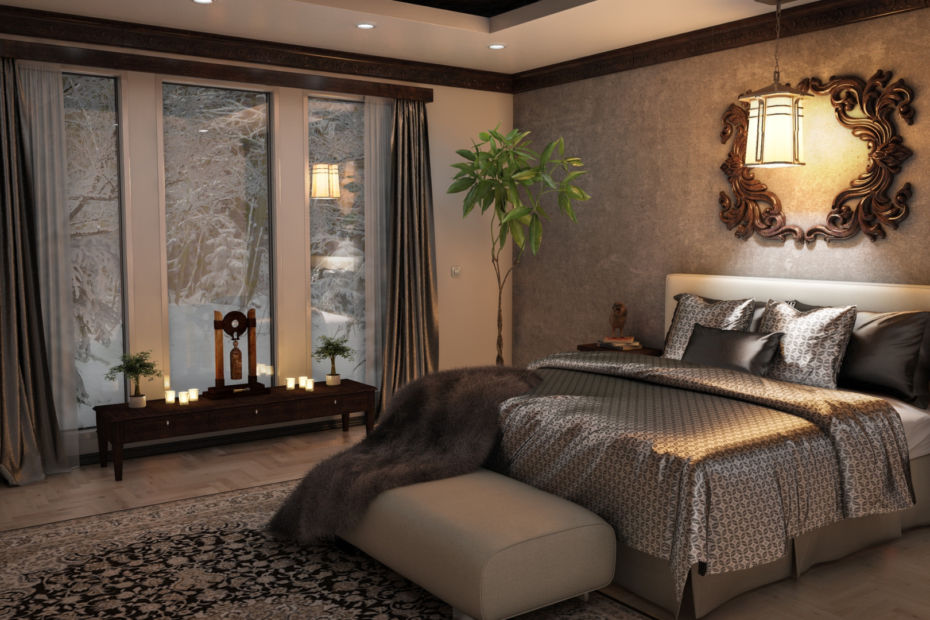You’ve heard the term “traditional” used in reference to great works of art, music, and literature, but have you thought about traditional interior design style? Traditional design has roots that can be traced back as far as the Renaissance, which relied more on artistry and symmetry than its modern counterpart. Traditional design typically promotes comfort, balance, symmetry, and flow, merging various art movements such as Baroque, Neoclassical, and Romantic.
What Is Traditional Interior Design?
Traditional interior design is a style that dates back to ancient times. It updates and blends the decorative styles of the past with contemporary design elements. The style generally includes ornately carved furniture, heavy woodwork, antique rugs, intricately carved Window Treatments and ceiling treatments, and arched doorways. It largely uses warm colors, such as creams, browns, and chocolates.
The History of Traditional Interior Design
For centuries, interior design has been about using objects to transform a space-to make ordinary spaces more comfortable and beautiful. Some interior designers use a lot of accessories and colors, while others prefer to use clean lines. Traditional interior design is often found in a more formal space, such as a library or office. It often includes lots of books, polished wood, and symmetrical arrangements.
Traditional interior design is a design style used for centuries and dates back to when ancient civilizations were first constructing homes. Traditional interior design was created to bring harmony to the home and capture nature’s essence.
Today’s Traditional Design
When we talk about today’s traditional design, it doesn’t have to be about simply being a timeless design element. Today’s traditional design means any design element that has been included in a style or design aesthetic for a long time. In today’s design world, traditional design can be an element that’s used today. It’s often used in interior design and fashion, though it’s also used in much more creative settings.
A traditional design is typically neutral, unfussy, and works well with various color schemes. This style typically features simple patterns, muted colors, and soft furnishings. While a traditional design can be filled with ornate furniture and decor, it is just as suitable for a more understated home.
Traditional Interior Design Style Characteristics
- Traditional interior design means more than just decorating. While designing a traditional room, you not only want to choose furniture that will match the style of your room but also the furniture that will reflect your personality.
- Textiles, like wallpaper, are commonly subtly patterned or neutral and may contain wool, velvet, heavy cotton, silk, and fur.
- Walls are typically painted in muted neutrals, but traditional motifs of delicately patterned wallpaper are also used such as floral, damask, or stripes.
- Darker wood finishes on floors and furniture are more common. Flooring material could vary from engineered hardwood to luxury vinyl and laminates but you can get wooden textures and styles in these flooring types. Websites like https://www.shadowwoodflooring.com/luxury-vinyl-flooring/ could have more suggestions on other traditional flooring styles.
- Traditional architectural elements such as crown molding and wainscoting may be used in interiors.
- Color palettes consist of subtle neutrals with a small amount of bold color.
Decorating Ideas for Traditional Interior Design
Design
When it comes to interior design, there are many different styles to choose from. Some prefer a more modern, minimalist style, while others are more drawn to traditional or classical designs. When decorating a home, it’s important to consider both your tastes and the age of the house. In case you are confused about your taste and choices, you can consider looking at some of the masterpieces of famous interior designers, such as Helen Coulston. You can mix and match your preference with their styles to create a timeless interior for your home.
Colors
Your home is a special place, and picking paint colors, wallpaper, and other interior design elements to reflect your personality is important. Traditional interior design colors in your home or business are easy. It is all about finding the right shades that will work well with your furniture, floor, and wall colors. When choosing traditional paint colors, keep the following in mind:
Styles
Decorating ideas for your home can be tough, especially if your home has a specific design style and you don’t want to abandon it completely. Traditional interior design styles are popular due to their timeless and classic designs. They can be found in many homes, and by sticking with them, you can create a look that is visually appealing, versatile, and pleasing to your eye. To maintain consistency with your traditional interior design, you can think of incorporating retro-style dining room furniture and decor. Consider vintage wooden dining tables and chairs with intricate detailing, paired with classic tableware and elegant, old-fashioned chandeliers. Additionally, a traditional kitchen can also add a sense of warmth and charm to your home. If interested, you can simply search “Traditional Kitchens” and explore various design inspirations online.
Furniture
Some people love traditional furniture. They think it’s timeless and will never go out of style. Others think it’s boring and can’t picture themselves sitting on it. Whether you love traditional furniture or hate it, there’s nothing wrong with it. No one said that only cool; modern furniture would look good in your home.
Lighting
Lighting is an integral component of any interior design, and traditional lighting is abundant in options. Floor lamps, pendant lights, sconces, and chandeliers–traditional lights are easy on the eyes and come in various styles, from classic to contemporary.
Conclusion
Decorative and architectural features define traditional interior design. The features are used to decorate the interior. Traditional interior decorating also involves furniture placement and designing the lighting. The furniture placement should be planned to make the room’s interior look larger. The design of this lighting should complement the furniture placement. The room’s interior decoration also involves using accessories such as paintings, statues, or wall sculptures
